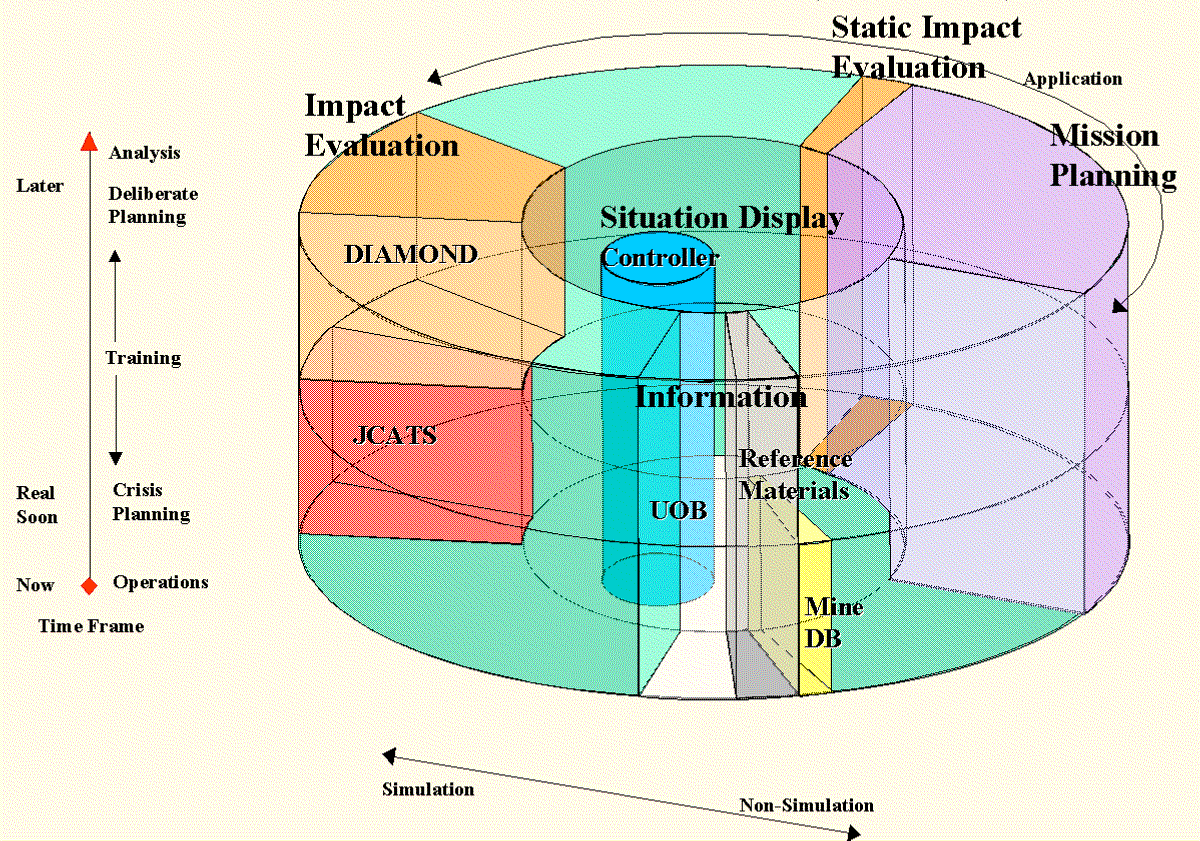 |
| Project Metadata | Keywords | |||||||||||||||||||||||||||||||||||||||||||||||||||||||||||||||||||||||||||||||||||||||||||||||||||||||||||||||||||||||||||||||||||||||||||||||||||||||||||||||||||||||||||
|
|
Create a design for a toolbox of Operations Other Than War (OOTW) tools that is accessible to the various communities that need tools to support them in their missions. The Defense Modeling and Simulation Office (DMSO) began in 2001 to create an OOTW toolbox, which was subsequently named the Flexible Asymmetric Simulation Technologies (FAST) toolbox. (These tools are also known as DIME/PMESII or HSCB tools.)
The devil is in the details: the content of OOTWs is tremendously diverse; the dimensionality of the tools themselves is great; and the total resulting dimensionality produces access problems.
The figure below illustrates the toolbox dimensionality problem, with some candidate tools shown for perspective.
 |
DMSO had collected statements of need, as follow:
... M&S tools today to train 4-star lead JTF for OOTW. Current models do not provide the capability to train to all missions ... particularly non-force-on-force, peacekeeping OOTW (EUCOM).
COCOM battle staffs currently lack a federated simulation that provides the detailed resolution needed in today's asymmetrical warfare environment (JFCOM).
A standardized, collaborative and distributed crisis action planning tool for analyzing COA, especially in areas of OOTW and SASO (PACOM, TRAC).
A model that can be used for disaster relief, refugee planning, peacekeeping, counter-drug, and stability operations (SOUTHCOM).
OOTW Simulation for SOF missions (SOCOM).
The OOTW strategic challenges include the following:
Combating Terrorism
Humanitarian Assistance
Show of Force Operations
Noncombatant Evacuations
Military Support to Civil Authorities
DoD Support to Counter Drug Operations
Nation Assistance / Support to Counterinsurgency
Peace Operations (e.g., Bosnia, Kosovo, Afghanistan, Iraq)
The OOTW operational challenges are represented by the following questions.
How do you understand the situation?
What interventions effect changes?
Which interventions are right - here?
What support structure is needed to enable these interventions?
What is the effect of the support structure on the situation?
Is someone actively working to counter the interventions?
What effects will result from their interventions?
How do you measure results?
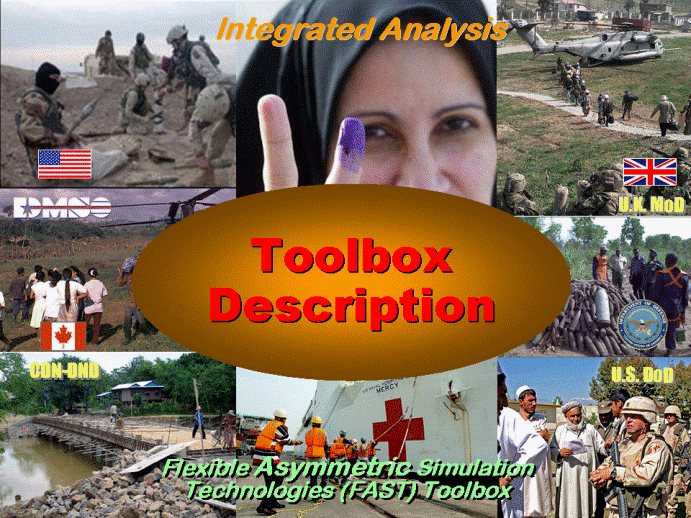 |
The concept for the tools is shown in the following two figures. The first figure relates the Diplomatic, Information, Military, and Economic (DIME) levers of power to the situation, described by the Political, Military, Economic, Social, Information, and Infrastructure (PMESII) variables, and the measurement of results through a PMESII model, yielding understanding.
 |
The second figure replaces the real world with the simulated reality of computer models.
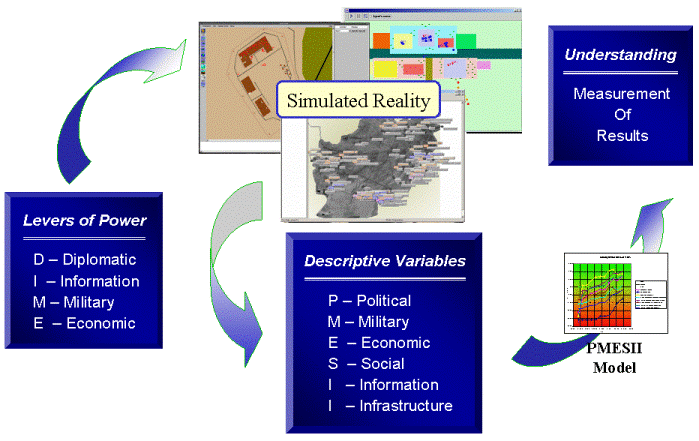 |
The project team, which includes Dynamics Research Corporation, Northrop Grumman, Alion, and CoTs determined on a set of goals, as follows:
Incrementally enhance toolbox functionality
Initial support by leveraging readily available tools
Add tools and functionality as funding, priorities and concepts allow
Functions should eventually cover OOTW Taxonomy/Technical Dimensions
Provide on the ground and reachback support to users
Provide access to authoritative force and C4I data and support the rapid update of scenario files
Provide automation support for time consuming, normally manual operations, enabling its use in the most demanding situations
Support analysis and decision making, without forcing results on the user.
The project has been a multi-year effort, with shifting focus to implement the incremental functionality enhancement. The figure below illustrates the major activities over time and for each project year. Note these activities included continuing, disciplined, and documented verification and validation (V&V) activities.
 |
The team created a data flow architecture as shown in the figure below, with control flows, XML data passing, other automated data passing, and manual data passing.
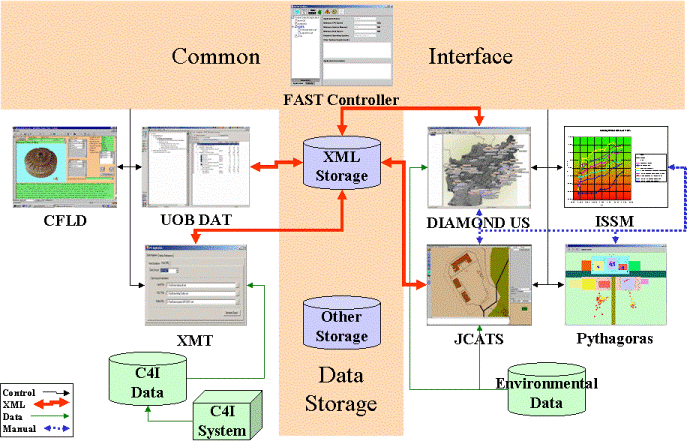 |
The team has also produced extensive documentation as shown in the next figure. Each tool is individually documented and the toolbox as a whole is documented.
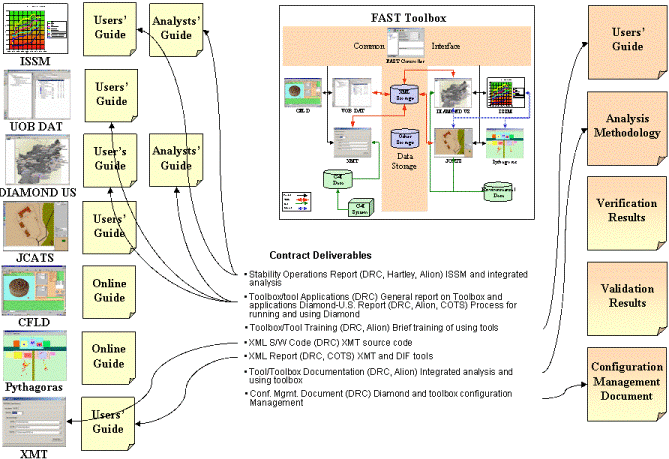 |
The next figure shows the relationships among the documents.
 |
The project team has produced a prototype toolbox that includes several tools.
The Controller provides a common interface and
supports data storage for the toolbox.
|
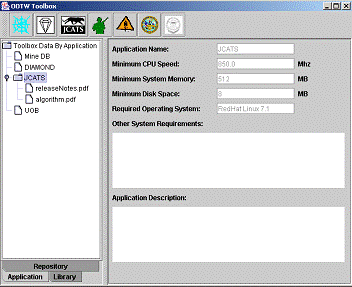 |
The Diplomatic and Military Operations in a
Non-warfighting Domain -US (DIAMOND US) is the US version
of the British DIAMOND simulation of OOTW.
|
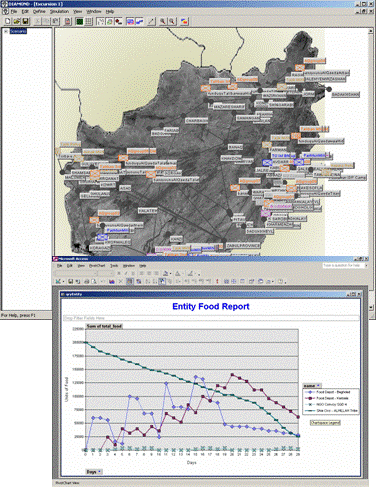 |
The Joint Conflict and Tactical Simulation (JCATS) is
a high definition combat simulation.
|
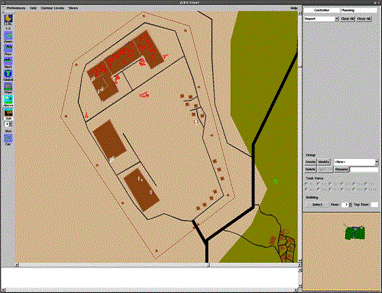 |
Pythagoras is an agent-based distillation.
|
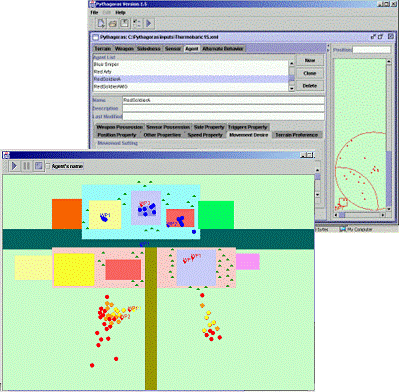 |
The Interim Semi-static Stability
Model (ISSM) is a Hartley Consulting model to create
and maintain awareness of the stability situation in an
OOTW.
|
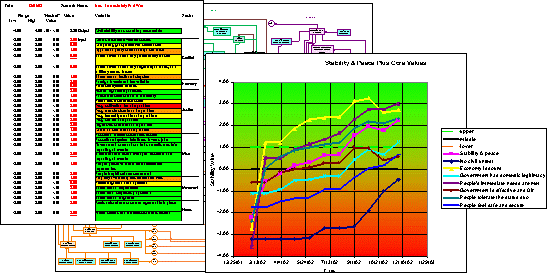 |
The Unit Order of Battle Data Access Tool (UOB DAT)
is a tool for accessing authoritative unit order of
battle data and creating tailored units.
|
 |
The XPOD Manipulation Tool (XMT) provides a
connection to a live, external C4I system .
|
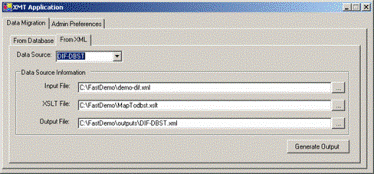 |
The Canadian Forces Landmine Database (CFLD) is a
Canadian tool to support mine awareness.
|
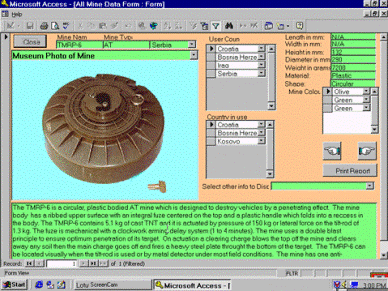 |
The primary connection among the tools consists of
XML files.
|
 |
The figure below shows the data flows with the XPODS.
 |
The figure below shows a DoD conceptual model of "Irregular" conflict. The "battles" represent different domains of conflict. The interior, dotted arrows connect some of the battles to the Information battle and represent non-kinetic effects. The exterior, solid arrows connect these battles with physical or kinetic influences. This model demonstrates new and important understanding of the nature of OOTW, yet it leaves out one critical "battle," the daily life battle. This last battle represents normalcy. To the extent that normalcy is disrupted by the other battles, the conflict is being lost. On the other hand, the influence of the daily life battle is the only sure way to win the other battles.
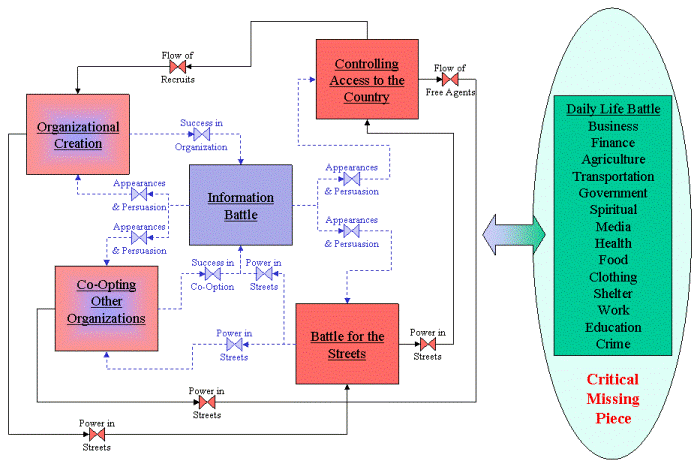 |
The figure below defines notation that is used in the next figure. It shows that, in general, more than one tool is needed to address any one of the battles above (due to the state of the art in understanding and modeling OOTW). The figure also shows how progress in a battle during simulated time is represented in the process view.
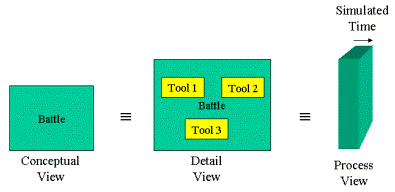 |
This figure shows the conceptual analysis methodology, which may be described as punctuated simulation. The analysis starting assumptions are used in a PMESII tool to define the values of the PMESII variables leading up to the start of the scenario. These values (and other environmental variables, such as forces and geography) are used to initiate the simulation of the appropriate battles through the available tools. If the scenario is divided into geographic regions, with separate simulations for each subregion, these are represented (conceptually) by additional battles. Rather than running the simulations through the whole course of the scenario, however, the simulations are stopped after a period of time and the results are fed into the PMESII tool. This process allows the analysts to collate and understand the results and feed back into the simulations (probably) different restart points due to factors that are missing in each simulation, but are either present in other simulations or are evaluated in the PMESII tool and by the analysts. The process is repeated until the scenario ends. The entire process represented by the figure is repeated for each excursion of the scenario.
 |
The figure below connects the current FAST Toolbox toolset with the battles.
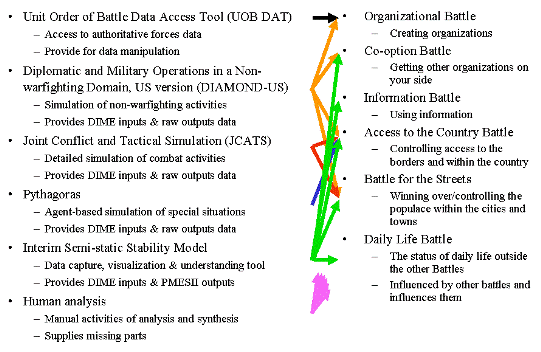 |
The figure below converts the conceptual analysis methodology into the actual analysis methodology employed with the FAST Toolbox. The Study Guidance in the uppper left corner (1) dictates the need for Final Report in the upper right corner (14). The analysis team must convert this into scenarios and excursions (2). The UOB supplies data for the Force data (3); the ISSM is used to create the Road to War (4); and JCATS and/or Pythagoras are used to develop selected inputs (5). The team uses these to create the Synchronization Matrix (6) and the Mission Analysis (7). The Toolbox supports automated translation of these data through the XMT to the DIAMOND model. DIAMOND is run (8) and its outputs are massaged by utilities (8). Some of these results are passed to JCATS and/or Pythagoras for special cases (10) and most are passed to the ISSM for DIME/PMESII evaluation (11). The results are assessed for technical (tool-based) issues (12). It is at this point that the results from separate representations of geographical subregions (if any) are combined. These results are passed to the Study WG Review for guidance (13). The cycle is repeated for a number of time periods. At the end of the cycle the outputs from these tools are digested by the analysts to produce the Report (14).
 |
A PowerPoint file that shows the flow of the process can be downloaded here.
The foundations for the FAST Toolbox as a whole, the individual tools, and the analysis methodology are solid; however, the structures built on that foundation are still in the prototype stage.
The state of theory is mixed. The logistics and transportation are well understood and can be modeled well, depending on the desired logistical protocol (e.g., push or pull). Combat is moderately well understood, despite gaps in detail and failures to model it correctly. DIME/PMESII relationships are poorly understood, with fragmented and often contradictory theory. And there is no unified theory that connects these pieces.
The conceptual foundations take these facts into account. Because validation of DIME/PMESII effects is extremely limited, competing theories and alternative methodologies are needed to define the ranges of results. No single model can handle all of the factors that impact complex situations (whether non-combat or combat) and human mediation and human gap-filling capabilities are required. Hence, the toolbox concept, the punctuated simulation methodology, and the prototype status of the toolbox composition.
The table below shows that some tools are toolbox components becauseof their subject functionality and some are components because they reduce the user workload. It also gives estimates on the user training time required for initial proficiency.
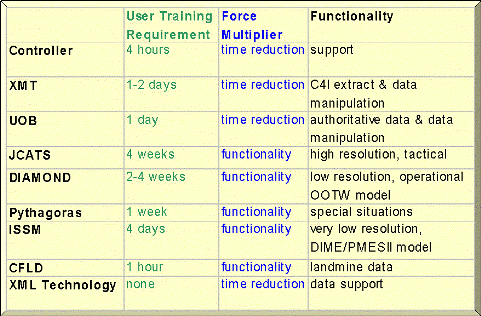 |
While DIME/PMESII effects define the purpose of the Toolbox, its coverage is not perfect. The figure below illustrates this with a comparison of the current toolbox with a possible future toolbox. Each configuration contains estimates of coverage by each tool of the DIME categories (top rows) and the PMESII categories (bottom rows). In each case (current and future configuration), the estimated total for the tool box (0.75 and 0.91, respectively) is higher than for any of the individual tools because of the synergy that the analysis methodology makes possible.
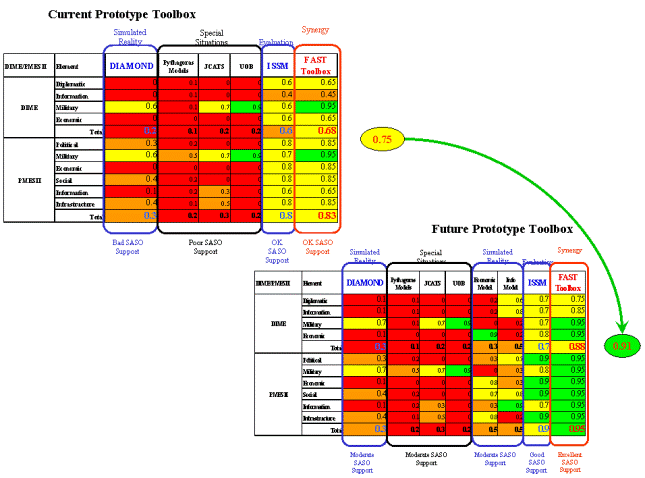 |
The following tables identify the modeling approaches used within the toolbox.
Time
| DIAMOND | Simulation |
| JCATS | Simulation |
| Pythagoras | Agent-based simulation |
| ISSM | Entries denoted by date |
Geography
| DIAMOND | Arc/node network XY coordinates over a raster map Data definition of node sizes, arc travel lengths |
| JCATS | Free form geography Lat/Long and height coordinates over raster map Detailed data definition of geographic features |
| Pythagoras | Notional geography, depending on particular model
created Cell coordinates Go/no-go geographic features |
| ISSM | No geography Potential for separate representations of geographical subareas |
Individuals
| DIAMOND | Command structure - upper levels are individuals or
staff No personalities |
| JCATS | Command structure - upper levels are individuals or
staff No personalities |
| Pythagoras | Limited command structure Structured personalities |
| ISSM | No command structure No personalities |
Infrastructure
| DIAMOND | Standard infrastructure types: node interfaces, 5
types of arcs, hospitals, shelters, food facilities,
airports, seaports Programmable communications |
| JCATS | Defined in data |
| Pythagoras | Defined in model definition Limited number in any given model |
| ISSM | National infrastructure types and projects: roads, bridges, railroads, airports, seaports, water & sewer, medical, agriculture, communications, electricity, oil, etc. |
Organizations
| DIAMOND | Multiple "parties" "Parties" have asymmetric relationships Separate civilians Implicit food production and civil repair ("government") |
| JCATS | Multiple sides Sides have only combat relationships |
| Pythagoras | Multiple sides Variable relationships |
| ISSM | Inputs relating to factions, indigenous government, NGOs, interveners, police, armed forces, paramilitary forces, etc. |
Institutions ("Daily Life Battle")
| DIAMOND | Indirect: through cyclical ISSM inputs |
| JCATS | Indirect: through cyclical ISSM inputs |
| Pythagoras | Would require special case model |
| ISSM | Social, civil & religious relationships Government & business: security, judicial, corrections, police, civil administration, finance, etc. Interactions & effect on populace |
Measures of Merit (MOMs)
| DIAMOND | Presence or absence of combat Force sizes Civilian deaths due to starvation, lack of law & order, combat (by whom) Infrastructure damage (by whom) Success in delivering food, supplies Production of Internally Displaced Persons Node ownership # of missions (by type) |
| JCATS | Traditional combat MOMs Other special MOMs, such as travel times |
| Pythagoras | Variable, depending on model |
| ISSM | Civil (internal) unrest is not present Economy is sound Government has domestic legitimacy Immediate needs of the people are satisfied Institutions of governance are effective and fair People are tolerant of the status quo Safe and secure environment is perceived Civil stability and durable peace exist |
Data Requirements
| DIAMOND | Node and arc data (location, connections, sizes,
etc.) "Party" force makeup & initial locations "Party" relationships Missions |
| JCATS | Standard combat model inputs |
| Pythagoras | Data are used to define the model to be created |
| ISSM | 90 DIME inputs (~40% can be supplied by DIAMOND /
Pythagoras) 34 PMESII inputs (~30% can be supplied by DIAMOND) Remainder of inputs must be inferred from the study definition and comparable historical situations Required on a periodic basis (weekly, monthly, etc.) |
| Hardware | Platform | laptop or desktop |
| CPU | newer Pentium based processor (~2006) | |
| Disk storage | 60 gigs or more | |
| Memory | 2 gigs or more (RAM is more important than processor speed | |
| Peripherals | CD burner, thumb drive support, network support | |
| Software | Operating System | Windows XP Professional, Linux |
| VMWare | version 4.0.0.4460 or later | |
| Office | Word, PowerPoint, Excel | |
| Database | Access 2003, RT version of Sybase | |
| Java | version 1.4.0 | |
| Applications | FAST Controller | version 1.0 |
| DIAMOND US | version 1.0 with DIAMOND 2.4.2 using DROMAS 3.0.4 | |
| JCATS | version 7.0 | |
| UOB Server and Client | version 7.93 | |
| CFLD | updated 2004-02-12 | |
| Pythagoras | latest version | |
| ISSM | version 4.0 | |
| XMT | version 1.0.0 |
The tools in the FAST Toolbox are generally designed to cover a single country or region within a country. The analysis methodology allows for the representation of regions or subregions to be combined into a representation of the entire country or region, respectively. This disection may be required because of limits on the resolution obtainable in any given simulation. These limits have not been completely determined as to numbers of entities, nodes, arcs, missions, etc., that are feasible.
There are also limits on the nature of the problems that can be examined with the FAST Toolbox. These limits have also not been completely determined. The current toolset is known to have limited capabilities in the economic area. It is also not designed to handle substantial combat issues with a high degree of confidence. Many problems may require creative approaches to model satisfactorily.
For more on the details of tool requirements see Analytical Tools for OOTW.
For more on the ISSM see Interim Semi-static Stability Model (ISSM).
If you arrived here using a keyword shortcut, you may use your browser's "back" key to return to the keyword distribution page.
Return to
Hartley's Projects Page